Covered spandex yarn has gained prominence in various textile applications, particularly in upholstery due to its durability, flexibility, and aesthetic appeal. This innovative yarn combines the benefits of spandex with additional protective layers, resulting in a versatile fabric that is not only functional but also visually attractive. As furniture and interior design trends evolve, the demand for fabrics that can withstand the rigors of daily use while maintaining a soft, pleasing touch has increased. Covered spandex yarn meets this need, making it a popular choice for upholsterers and designers alike.
Covered spandex yarn

The world of upholstery has long relied on a multitude of materials, each bringing its unique characteristics to the table. Among these, covered spandex yarn stands out due to its remarkable balance of elasticity, strength, and comfort. The process of covering spandex with other fibers or materials creates a yarn that successfully mitigates some of the drawbacks associated with traditional spandex while amplifying its advantages.
Definition and Composition
Covered spandex yarn consists of a core of spandex, enveloped by a layer of another fiber, commonly polyester, nylon, or cotton. This structure offers several benefits, including increased durability and reduced pilling. The outer layer protects the spandex, enabling it to retain its unique stretchability without compromising the aesthetic appeal of the fabric. This combination allows designers to create upholstery pieces that are not only visually striking but also practical, as they can endure high levels of wear and tear.
By utilizing covered spandex yarn in upholstery, manufacturers can produce fabrics that offer a luxurious feel while also being able to withstand the rigors of everyday use. The result is a material that appeals to consumers seeking comfort and durability in their home furnishings. Furthermore, when combined with various dyes and finishes, covered spandex yarn can yield an impressive range of textures and colors that enrich the overall design palette available to designers and consumers.
Applications in Upholstery
The versatility of covered spandex yarn makes it an ideal candidate for a wide array of upholstery applications. From sofas and chairs to cushions and drapes, this unique yarn can adapt to various styles, ranging from contemporary to traditional. Each application draws on the yarn’s inherent qualities, such as its elasticity, which allows for a snug fit while also providing comfort and support.
The substantial stretch of covered spandex yarn also allows it to conform closely to the shape of furniture. This adaptability is particularly beneficial for upholstered furniture pieces that require a tailored look. By incorporating designs that utilize this material, designers and manufacturers can achieve a seamless, polished finish that enhances the overall aesthetics of a space.
Cushioning is another area where covered spandex yarn excels. Its stretchability provides excellent support while maintaining an inviting surface for sitting. By using textiles made from covered spandex yarn, consumers can enjoy both the comfort of soft fabrics and the structural integrity that comes from the enhanced durability of this composite yarn. In a world where consumers prioritize both style and functionality, covered spandex yarn serves as an appealing option for achieving the ideal balance.
Long-lasting Properties
Consumers today are more aware of the longevity and environmental impact of their purchasing decisions. Covered spandex yarn stands out for its resistance to wear and tear, making it an attractive choice for upholstery. This durability can be attributed to the protective outer layer, which significantly reduces the risk of fraying or tearing. The ability to maintain its tensile strength over time contributes to its sustainability, as products made from covered spandex yarn often have a longer life cycle, reducing the need for replacements.
Moreover, covered spandex yarn resists color fading, ensuring that upholstery retains its vibrancy even in sunlit spaces. This quality opens the door to a vast range of design options without the worry that colors will degrade after exposure to light. This resistance not only extends the aesthetic appeal of the fabric but also simplifies maintenance for consumers, allowing them to keep their upholstery looking fresh with minimal effort.
As consumers continue to prioritize sustainability and longevity in their purchasing decisions, the durability offered by covered spandex yarn becomes an increasingly attractive option. Manufacturers who choose this material can boast about its long-lasting properties while providing customers with a product that fulfills their aesthetic and functional needs.
Spandex covered yarn hs code

In today’s global marketplace, understanding how textiles are classified is essential for manufacturers, importers, and exporters. The spandex covered yarn hs code serves as a vital identifier for businesses looking to engage in trade involving this type of material.
Understanding HS Codes
Harmonized System codes are standardized numerical codes used internationally to classify traded products. They serve various functions, from tariff application and trade statistics to facilitating smoother customs processes. For the textile industry, accurate HS classification is crucial because it affects everything from import duties to regulatory requirements.
Spandex covered yarn is categorized specifically within the broader textile classification framework. Understanding the nuances of the HS code can enable manufacturers and retailers to navigate complex international trade scenarios with more ease. For instance, having the correct HS code ensures compliance with local regulations and helps to avoid potential disputes at customs checkpoints.
Classification of Covered Spandex Yarn
The HS codes for covered spandex yarn are often linked to several variables, including the composition and coverage characteristics of the yarn itself. While the specifics may vary slightly from one country to another, this code usually falls under the category for synthetic textile fibers. Manufacturers must pay close attention to the details of their product’s composition when classifying it under the right HS code because misclassification can lead to hefty fines, delays, and reputational damage.
Furthermore, it is essential for importers and exporters to remain updated on any changes in HS codes that may arise due to trade policies or international agreements. This is particularly important in the fast-evolving landscape of textiles and fashion, where innovations like covered spandex yarn are continually being introduced and gaining traction.
Importance for Trade Regulations
For manufacturers involved in the production of upholstery using covered spandex yarn, understanding the associated HS code can lead to significant benefits. Proper classification helps streamline trade operations, facilitating smoother import and export processes. This not only mitigates potential financial liabilities but also builds a trustworthy reputation in the global market.
Moreover, understanding the HS classification can enhance transparency and pave the way for better communication with suppliers and clients. When companies clearly identify their products by the correct HS code, they allow their supply chains to function more effectively, reducing the likelihood of errors that could disrupt the flow of goods.
Opportunities for Sustainable Practices
The classification of covered spandex yarn under the appropriate HS code also presents opportunities for sustainability initiatives. As consumers become more environmentally conscious, regulations surrounding the textile industry increasingly focus on sustainability. By correctly identifying their products according to their HS code, manufacturers can engage in green practices, such as recycling and eco-friendly production methods more effectively.
Additionally, this knowledge empowers businesses to capitalize on various trade agreements and incentives focused on sustainable textiles, enhancing their competitive edge in an ever-evolving marketplace. As a result, navigating the complexities of HS codes can lead to significant benefits far beyond basic compliance.
Spandex yarn price
Understanding the spandex yarn price is essential for manufacturers and retailers involved in the upholstery business. The cost of this innovative material dramatically influences budgeting, sourcing decisions, and ultimately the final pricing of upholstered products.
Factors Influencing Price
A variety of factors contribute to the cost of spandex yarn, ranging from raw material prices to manufacturing processes. The elasticity of spandex yarn inherently makes it a more complex material to produce compared to traditional fibers, which can elevate production costs. Therefore, manufacturers must carefully evaluate the processes involved, including the sourcing of raw materials, production techniques, and labor costs, all of which play a role in determining the final price of spandex yarn.
Additionally, market fluctuations in the prices of petroleum (from which synthetic fibers like spandex are derived) and competitive pricing among suppliers can lead to variations in yarn costs. For instance, an increase in global oil prices can directly impact the cost of spandex production, making it essential for manufacturers to monitor these trends closely.
Pricing Dynamics for Upholstery
In the upholstery sector, spandex yarn serves as a vital component for both structural and decorative elements. However, its cost is not solely derived from the yarn itself. The overall price of upholstery products that utilize spandex yarn is influenced by several factors, including design complexity, additional materials required, and the labor involved in crafting the final piece.
For example, high-end upholstery goods leveraging covered spandex yarn may command a premium price due to intricate designs and craftsmanship. In contrast, mass-produced items may see lower pricing due to economies of scale, as a significant number of units can be produced quickly. Retailers should thus weigh the benefits of using spandex yarn against the pricing dynamics in the market, ensuring that their products align with consumer expectations around quality, durability, and overall value.
Competitive Landscape
The competitive landscape vastly shapes spandex yarn pricing. As new players enter the market and established brands innovate their offerings, pricing can fluctuate significantly. Manufacturers that offer unique blends or innovative production techniques may command higher prices. Conversely, suppliers in a price-driven segment of the market may face pressure to lower costs to maintain competitiveness.
Additionally, the increasing demand for sustainable practices in manufacturing is also reshaping spandex yarn pricing. Currently, many consumers are willing to pay a premium for eco-friendly textiles, which drives suppliers to explore sustainable production methods—often at an increased cost. As consumers become more conscious of the environmental impact, manufacturers will need to balance pricing strategies while integrating sustainability into their operations.
Long-term Investment
While the initial cost of spandex yarn can be higher than traditional fibers, its long-term benefits and durability may justify the investment. Upholstered products made with covered spandex yarn tend to last longer and retain their aesthetic appeal more effectively than those made from less durable fabrics. Therefore, customers can derive better value over time, making spandex yarn a compelling choice for upholstery, particularly in high-traffic areas.
Manufacturers who effectively communicate these long-term advantages to customers can position themselves favorably within a crowded marketplace. By emphasizing the benefits of covered spandex yarn, including its durability, ease of care, and versatility, businesses can create a strong value proposition that resonates with consumers looking for products that withstand the test of time.
Difference between polyester and spandex
When considering textile options for upholstery, understanding the difference between polyester and spandex is crucial for making informed choices. Both fibers serve distinct purposes and offer unique benefits, often used in combination to create fabrics that fulfill consumers’ demands for comfort, durability, and style.
Characteristics of Polyester
Polyester is a synthetic fiber renowned for its durability, resistance to shrinking, and ability to retain colors. Often used in upholstery, polyester provides a sturdy base that withstands daily wear without showing significant signs of damage. This fiber type is also relatively low-maintenance, making it an appealing choice for consumers who prioritize easy care in textiles.
Offering a range of textures from smooth to woven, polyester’s versatility allows designers to craft distinctive fabric styles that capture various aesthetic preferences. As a result, polyester’s overarching durability and aesthetic flexibility make it a popular fiber in the upholstery arena.
However, while polyester excels in strength, it lacks the stretchability that defines spandex. Therefore, upholstery made solely from polyester may not offer the same level of comfort, employing a firmer structure that may leave some consumers desiring a softer feel. This limitation is where the inclusion of spandex comes into play.
Characteristics of Spandex
Spandex, on the other hand, is celebrated for its remarkable elasticity and flexibility. Known for its ability to stretch significantly without losing its original shape, spandex effectively enhances the comfort of upholstered pieces. It’s often blended with other fibers, like polyester, to create textiles that combine strength with stretch.
Although spandex excels in elasticity, it can be more susceptible to wear, especially when exposed to harsh conditions over time. By itself, spandex may lack the durability needed for heavy use—a key area where polyester shines, thus highlighting the importance of their dual usage in the upholstery sector.
The Synergistic Partnership
The combination of polyester and spandex in upholstery creates a synergistic partnership that takes advantage of both fibers’ strengths. Covered spandex yarn, which incorporates spandex, provides the bounce and comfort expected in upholstery not found in polyester alone. This unique blend ensures that upholstered items are not only attractive but also functional; spandex’s stretchability enhances the comfort of cushions, while polyester’s durability promises longevity.
In practice, this means that consumers benefit from the best of both worlds—fabrics that feel soft and inviting while standing up to the demands of daily use. The blend offers a wide range of colors and patterns that can cater to any aesthetic preference, allowing designers the freedom to craft beautiful pieces that are practical in residential or commercial settings.
Cost Considerations
It’s important to address that the cost differences between polyester and spandex can also impact decision-making in upholstery design. Polyester tends to be more affordable than spandex, primarily due to its widespread availability and simpler manufacturing processes. However, incorporating spandex, especially when used in covered spandex yarn, may elevate overall production costs due to its unique properties and benefits.
Consumers, manufacturers, and suppliers must weigh these cost considerations alongside the desired qualities and performance of the finished products. In the long run, investing in the combination of polyester and spandex often translates into higher customer satisfaction, making covered spandex yarn an appealing choice for a wide variety of upholstery applications.
Conclusion
Harnessing the properties of covered spandex yarn in upholstery offers immense potential and opportunity for designers and manufacturers alike. Its unique blend of elasticity, durability, and aesthetic versatility creates a fabric that is well-suited for modern living spaces, meeting the needs of consumers seeking both comfort and resilience. As trade regulations, cost structures, and sustainability considerations evolve, the significance of materials like covered spandex yarn will continue to shape the future of upholstery, emphasizing a blend of functionality and function. Ultimately, understanding the properties, classification, pricing dynamics, and comparative characteristics of materials like polyester and spandex paves the way for wiser choices in upholstered designs, enhancing the overall experience for both the creators and users of these essential home furnishings.
Support by us



